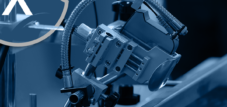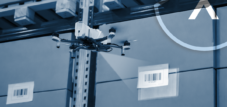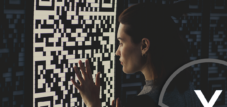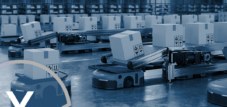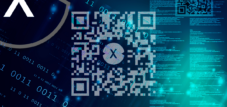Logistics/Intralogistics: The magic of invisible eyes – How sensor technology leads RFID and 2D matrix code technology into the future!
Language selection 📢
Published on: July 2, 2023 / update from: July 2, 2023 - Author: Konrad Wolfenstein

Sensor technology for RFID and 2D matrix code technology – Image: Xpert.Digital / metamorworks|Shutterstock.com
Efficient warehouse management in real time: The power of 2D matrix codes and RFID technology
Using 2D matrix codes and RFID technology to tag products in the warehouse has proven to be an extremely effective way to accurately track inventory and ensure a smooth shipping process. These technologies allow companies to know the exact location of specific products in real time while minimizing inventory errors.
The 2D matrix code, also known as a QR code, is a two-dimensional barcode that encodes information in the form of square modules. In the warehouse context, the QR code is attached to the individual products. Each code contains a unique identification number assigned to the corresponding product. This identification number can then be recorded in a warehouse management system and linked to other information such as product description, storage location, delivery date and much more.
The advantages of using 2D matrix codes are obvious. On the one hand, they are extremely space-saving because they can store a large amount of information in a small code. In addition, they are very easy to scan, both with standard smartphones and with dedicated barcode scanners. This allows warehouse staff to quickly and efficiently record products and update inventory in real time.
In addition to 2D matrix code technology, RFID technology (Radio-Frequency Identification) can also be used. RFID tags are small, wireless devices that can send and receive information via radio waves. Each product in the warehouse is equipped with an RFID tag that contains a unique identifier. Using RFID readers, warehouse employees can pinpoint the location of products by scanning the tags.
The advantage of RFID lies in its contactless and wireless nature. In contrast to 2D matrix codes, the tags do not have to be scanned directly, but can be captured from a distance of several meters. This allows for quick and efficient inventory as warehouse staff can simply pass the tags near the readers without having to scan each product individually.
Using 2D matrix codes and RFID tags to identify products in the warehouse offers numerous advantages. On the one hand, it enables precise inventory tracking in real time, so that companies know exactly which products are in which location. This not only makes the picking and shipping process easier, but also minimizes inventory errors that can lead to lost costs and time.
Additionally, precise inventory tracking enables effective inventory planning and management. Companies can optimize inventory, avoid shortages and ensure a smooth supply chain. In addition, by accurately tracking products in the warehouse, they can identify the need for reorders early and minimize bottlenecks in product availability.
➡️ 2D matrix codes and RFID technology provide an effective way to precisely track inventory and optimize the shipping process. By implementing these technologies, companies can increase efficiency, reduce costs and improve customer satisfaction. It is clear that the use of 2D matrix codes and RFID technology plays an important role in warehouse management, helping companies stay competitive and improve their logistics processes.
RFID vs. 2D matrix code technology
No, RFID (Radio-Frequency Identification) and 2D matrix codes are not the same thing, they differ in how they work and the technologies used.
Differences:
- Technology: RFID is based on wireless communication via radio waves between an RFID tag and a reader. The tags send and receive information while the readers capture the tags. On the other hand, 2D matrix codes are encoded with visual patterns and captured by special scanners or even smartphone cameras.
- Detection method: RFID enables contactless detection of the tags from a certain distance. The tags do not have to be directly visible and can be recognized through materials such as plastic or paper. With 2D matrix codes, on the other hand, the codes must be visible and captured directly by a scanner or camera.
- Data capacity: RFID tags can store a larger amount of information than 2D matrix codes. The tags can contain multiple data fields and are more flexible in storing additional information about a product. 2D matrix codes have limited capacity and can store less data.
Similarities:
- Identification: Both RFID and 2D matrix codes are used to mark and identify products. They allow companies to track the precise location of products and store information about them, such as product descriptions, storage location and delivery dates.
- Warehouse management: Both RFID and 2D matrix codes are used in warehouse management to precisely track inventory and optimize the shipping process. They enable efficient inventory and smooth picking and help minimize inventory errors.
- Increased efficiency: Both RFID and 2D matrix codes help to improve efficiency in logistics. They enable accurate, real-time inventory tracking, effective inventory planning and management, and timely identification of needs and shortages.
➡️ Although RFID and 2D matrix codes are different technologies, they complement each other in practice. Companies can use both technologies to take advantage of both systems and make inventory management even more effective.
Comparison of sensor technologies: RFID vs. 2D matrix codes for product identification and data capture
RFID and 2D matrix codes use different sensor technologies to capture and transmit information.
RFID (Radio-Frequency Identification) is based on the use of radio waves and consists of three main components: the RFID tag, the RFID reader and the backend system. The RFID tag contains an integrated microchip and antenna that allow it to send and receive information wirelessly. The RFID reader emits electromagnetic signals to activate the tags within its range and capture their data. The tags can be passive and receive power from the reader or active and have their own power source. The information is then transferred to the backend system where it is processed and stored.
2D matrix codes, such as QR codes, are based on visual patterns that encode information. The codes consist of square modules that represent information in the form of black and white areas. They are captured by special scanners or smartphone cameras by reading the pattern and decoding the data it contains. The data is then processed and interpreted by appropriate software.
Similarities:
- Identification: Both RFID and 2D matrix codes are used to mark and identify products. They allow companies to track the precise location of products and store information about products.
- Automated capture: Both RFID and 2D matrix codes enable automated capture of information. RFID tags can be captured wirelessly and contactlessly, while 2D matrix codes can be captured visually. Both technologies enable fast and efficient data collection.
- Applications: Both RFID and 2D matrix codes are used in various application areas including warehouse management, logistics, retail, transportation and more. They help accurately track inventory, optimize the shipping process, and minimize inventory errors.
➡️ Although RFID and 2D matrix codes use different sensor technologies, there are still similarities in their function, especially in terms of identification and automated detection. Both technologies offer efficient solutions for product identification and enable improved warehouse management and logistics processes.
The Evolution of Logistics: How the Barcode Paved the Way for Global Sensor Technology
Global sensor technology in logistics has undergone remarkable development over the last 30 years. The introduction of the barcode can be seen as an important milestone that laid the foundation for this development.
The use of barcodes for product identification and data capture revolutionized the logistics industry. Barcodes made it possible to uniquely identify products and store information about them. This enabled efficient tracking and monitoring of goods throughout the entire logistics process, from warehousing to transportation and delivery. Automated barcode data collection minimized human errors and improved inventory tracking accuracy.
The introduction of barcodes led to increased efficiency and productivity in logistics. Inventories could be tracked precisely and bottlenecks avoided. Picking goods became faster and more error-free as barcode scanners replaced manual data entry. Supply chains were optimized, resulting in reduced lead times and improved customer service.
Over the last 30 years, sensor technology in logistics has evolved to meet growing requirements. In addition to barcodes, other technologies such as RFID (Radio-Frequency Identification) and 2D matrix codes were introduced. RFID enables wireless and contactless data collection and opened up new opportunities for the logistics industry. Products can be equipped with RFID tags that contain a unique identifier and can be automatically captured without needing to be visible. This enables even more efficient inventory tracking and faster information collection.
The introduction of 2D matrix codes such as QR codes expanded the possibilities for data collection. QR codes can be read by standard smartphones or special scanners and offer the possibility of storing larger amounts of information in a compact code. This enables more detailed tracking of products and opens up new application areas such as mobile inventory and inventory management.
The development of sensor technology in logistics was closely linked to progress in information technology. Advances in data processing, communications technology and software have made it possible to process and analyze sensor data in real time. This has led to further optimization of logistics processes and improved decision making.
➡️ The introduction of the barcode laid the foundation for the development of global sensor technology in logistics. From the beginnings of barcode technology to today's use of RFID and 2D matrix codes, sensor technology has continually evolved to meet the needs of the logistics industry and enable more efficient, transparent and precise processes.
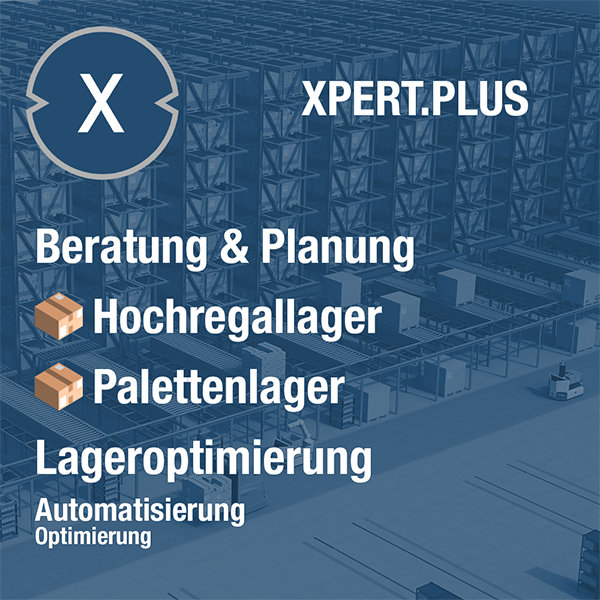
Xpert.Plus warehouse optimization - high-bay warehouses such as pallet warehouses consulting and planning
Xpert.plus-logistics advice and logistics optimization-industry expert, here with its own 'Xpert.digital Industrie-Hub' of over 1,000 specialist contributions
Xpert.Plus is a project from Xpert.Digital. We have many years of experience in supporting and advising on storage solutions and in warehouse optimization, which we bundle in a large network under Xpert.Plus.
I would be happy to serve as your personal advisor.
You can contact me by filling out the contact form below or simply call me on +49 89 89 674 804 (Munich) .
I'm looking forward to our joint project.
Xpert.Digital – Konrad Wolfenstein
Xpert.Digital is a hub for industry with a focus on digitalization, mechanical engineering, logistics/intralogistics and photovoltaics.
With our 360° business development solution, we support well-known companies from new business to after sales.
Market intelligence, smarketing, marketing automation, content development, PR, mail campaigns, personalized social media and lead nurturing are part of our digital tools.
You can find out more at: www.xpert.digital – www.xpert.solar – www.xpert.plus








